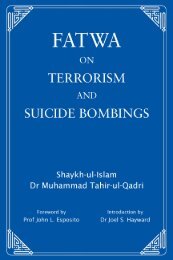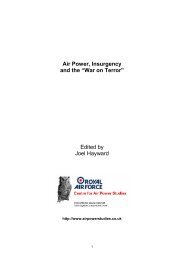Air Power, Insurgency and the âWar on Terrorâ - Prof. Joel Hayward's ...
Air Power, Insurgency and the âWar on Terrorâ - Prof. Joel Hayward's ...
Air Power, Insurgency and the âWar on Terrorâ - Prof. Joel Hayward's ...
You also want an ePaper? Increase the reach of your titles
YUMPU automatically turns print PDFs into web optimized ePapers that Google loves.
<str<strong>on</strong>g>Air</str<strong>on</strong>g> <str<strong>on</strong>g>Power</str<strong>on</strong>g> <str<strong>on</strong>g>and</str<strong>on</strong>g> <str<strong>on</strong>g>Insurgency</str<strong>on</strong>g>: Early RAF Doctrine<br />
of <str<strong>on</strong>g>the</str<strong>on</strong>g> enemy, direct support of British troops <str<strong>on</strong>g>and</str<strong>on</strong>g> <str<strong>on</strong>g>the</str<strong>on</strong>g> observati<strong>on</strong> of artillery fire. The<br />
ability of aircraft to enhance <str<strong>on</strong>g>the</str<strong>on</strong>g> morale of local troops is noted, as is <str<strong>on</strong>g>the</str<strong>on</strong>g> ability to enhance<br />
communicati<strong>on</strong>s between army forces in <str<strong>on</strong>g>the</str<strong>on</strong>g> field <str<strong>on</strong>g>and</str<strong>on</strong>g> <str<strong>on</strong>g>the</str<strong>on</strong>g>ir headquarters. Here <str<strong>on</strong>g>the</str<strong>on</strong>g> need<br />
for close co-operati<strong>on</strong> is stressed: for instance, “during an operati<strong>on</strong>, air observers must be<br />
fully informed of <str<strong>on</strong>g>the</str<strong>on</strong>g> situati<strong>on</strong> up to <str<strong>on</strong>g>the</str<strong>on</strong>g> moment of <str<strong>on</strong>g>the</str<strong>on</strong>g>ir leaving for a flight,” <str<strong>on</strong>g>and</str<strong>on</strong>g> it is also<br />
suggested that an air force liais<strong>on</strong> officer should be attached to any advancing column to<br />
provide advice to <str<strong>on</strong>g>the</str<strong>on</strong>g> comm<str<strong>on</strong>g>and</str<strong>on</strong>g>er <strong>on</strong> all aspects of air operati<strong>on</strong>s. 56<br />
O<str<strong>on</strong>g>the</str<strong>on</strong>g>r aspects of support are also explored, such as <str<strong>on</strong>g>the</str<strong>on</strong>g> ability to provide support or relief<br />
for isolated detachments, including <str<strong>on</strong>g>the</str<strong>on</strong>g> capacity to provide supplies by parachute, as well<br />
as casualty evacuati<strong>on</strong>. The escorting of ground c<strong>on</strong>voys is also seen as an important role,<br />
toge<str<strong>on</strong>g>the</str<strong>on</strong>g>r with that of direct offensive acti<strong>on</strong> against forces remote from <str<strong>on</strong>g>the</str<strong>on</strong>g> reach of <str<strong>on</strong>g>the</str<strong>on</strong>g><br />
ground forces. The chapter finishes with a summary which looks at problems relating to<br />
basing <str<strong>on</strong>g>and</str<strong>on</strong>g> support, <str<strong>on</strong>g>and</str<strong>on</strong>g> c<strong>on</strong>cludes that <str<strong>on</strong>g>the</str<strong>on</strong>g> optimal approach is <strong>on</strong>e where all aircraft<br />
should be c<strong>on</strong>centrated at a few central air bases, both to ease <str<strong>on</strong>g>the</str<strong>on</strong>g> logistics burden <str<strong>on</strong>g>and</str<strong>on</strong>g> to<br />
ensure that <str<strong>on</strong>g>the</str<strong>on</strong>g>y can be secured by adequate military garris<strong>on</strong>s.<br />
Yet <str<strong>on</strong>g>the</str<strong>on</strong>g> greatest difference from <str<strong>on</strong>g>the</str<strong>on</strong>g> previous doctrine in this area without doubt comes in<br />
<str<strong>on</strong>g>the</str<strong>on</strong>g> c<strong>on</strong>text within which <str<strong>on</strong>g>the</str<strong>on</strong>g> use of force in general, <str<strong>on</strong>g>and</str<strong>on</strong>g> that of air power in particular, is<br />
situated. C<strong>on</strong>sider for instance <str<strong>on</strong>g>the</str<strong>on</strong>g> following statement:<br />
The basis of law <str<strong>on</strong>g>and</str<strong>on</strong>g> order in an uncivilized country is a sound <str<strong>on</strong>g>and</str<strong>on</strong>g><br />
str<strong>on</strong>g administrati<strong>on</strong>. The strength of an administrati<strong>on</strong> in <str<strong>on</strong>g>the</str<strong>on</strong>g> eyes<br />
of a native is judged by its capacity to mete out suitable <str<strong>on</strong>g>and</str<strong>on</strong>g> adequate<br />
punishment without delay when misbehaviour occurs. 57<br />
Taken toge<str<strong>on</strong>g>the</str<strong>on</strong>g>r with previously noted comments regarding <str<strong>on</strong>g>the</str<strong>on</strong>g> need for military acti<strong>on</strong> to<br />
be c<strong>on</strong>sidered as <str<strong>on</strong>g>the</str<strong>on</strong>g> last resort, <str<strong>on</strong>g>and</str<strong>on</strong>g> in particular that <str<strong>on</strong>g>the</str<strong>on</strong>g> acti<strong>on</strong> undertaken had to have<br />
due regard for <str<strong>on</strong>g>the</str<strong>on</strong>g> desired end-state, it is clear that a far more sophisticated approach to<br />
<str<strong>on</strong>g>the</str<strong>on</strong>g> problems of “air policing” had been developed in a relatively short period of <strong>on</strong>ly five<br />
years. This reflects <str<strong>on</strong>g>the</str<strong>on</strong>g> significant gaining of experience in this area during that period, as<br />
<str<strong>on</strong>g>the</str<strong>on</strong>g> RAF took <strong>on</strong> first <str<strong>on</strong>g>the</str<strong>on</strong>g> complete resp<strong>on</strong>sibility for all military activity in Iraq, <str<strong>on</strong>g>and</str<strong>on</strong>g> <str<strong>on</strong>g>the</str<strong>on</strong>g>n<br />
provided significant support in <str<strong>on</strong>g>the</str<strong>on</strong>g> North-West Fr<strong>on</strong>tier area (now Afghanistan).<br />
AP 1300 was not amended until 1940. Yet <str<strong>on</strong>g>the</str<strong>on</strong>g>re was a significant addendum provided<br />
in 1931 in <str<strong>on</strong>g>the</str<strong>on</strong>g> form of ASM 46. This was actually issued in <str<strong>on</strong>g>the</str<strong>on</strong>g> c<strong>on</strong>fidential document<br />
(CD) series, which specifically stated that it was intended to “supplement <str<strong>on</strong>g>the</str<strong>on</strong>g><br />
general principles outlined in Chapter XIV of <str<strong>on</strong>g>the</str<strong>on</strong>g> “Royal <str<strong>on</strong>g>Air</str<strong>on</strong>g> Force War Manual<br />
Part 1,” <str<strong>on</strong>g>and</str<strong>on</strong>g>, fur<str<strong>on</strong>g>the</str<strong>on</strong>g>rmore, that all RAF officers were expected not <strong>on</strong>ly to be familiar with<br />
40<br />
<str<strong>on</strong>g>Air</str<strong>on</strong>g> <str<strong>on</strong>g>Power</str<strong>on</strong>g>, <str<strong>on</strong>g>Insurgency</str<strong>on</strong>g> <str<strong>on</strong>g>and</str<strong>on</strong>g> <str<strong>on</strong>g>the</str<strong>on</strong>g> “War <strong>on</strong> Terror”





